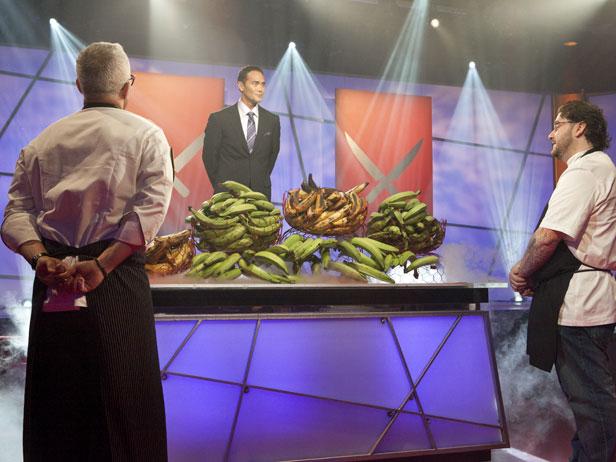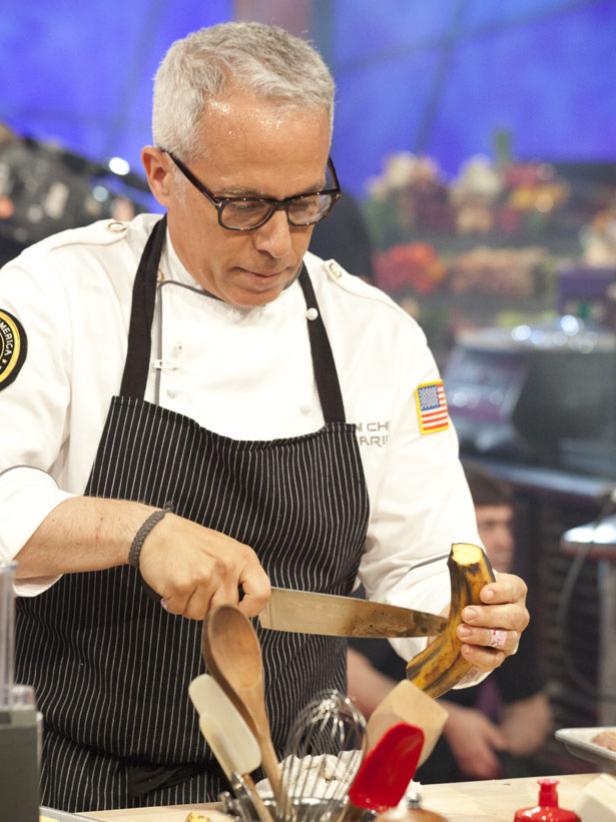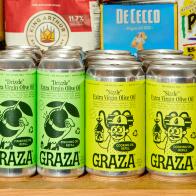Plantains — Iron Chef America Ingredients 101

On a recent visit to Jamaica, just about every meal my wife and I sampled came with a side order of beautiful golden plantain strips, shallow-fried and served with a sprinkling of salt and nutmeg. They were the perfect accompaniment to grilled local fish or large plates of tear-inducing jerk chicken, and were so delicious a memory that they have now become a regular staple in the Majumdar pantry.
Watching the Iron Chef and his challenger has definitely given me some new ideas for how to use plantains in my own kitchen, and I hope to persuade those of you who have not yet tried them to give the banana’s less well-known cousin a try yourself.
Plantains, or “cooking banana” as they are sometimes known, are part of the same family as the banana and are often mistaken for them. However, plantains and bananas differ in a number of important areas, both in how they look and in how they are prepared.
Although both are fruits are often grown together on the same plantations, plantains are larger than bananas, much harder to peel (particularly in their unripe state) and contain a lot less natural sugar than bananas.

Because of this, plantains are very starchy and, unlike bananas, tend not to be eaten raw unless they are very ripe indeed. They are most often used as a vegetable unless, again, when they are very ripe, when you may see them appearing in desserts.
If you come across plantains in the grocery store, you will find them in varying degrees of ripeness from very firm green ones all the way down to plantains that are almost totally black. Once they are harvested, they usually ripen in about seven to 10 days.
On the nutritional plus side, plantains contain almost no cholesterol, salt or fat, so they are considered beneficial for those watching their heart health. They also have a high level of dietary fiber and contain good levels of vitamins and minerals such as beta carotene and potassium.
On the downside, the fact that plantains are starchy does mean that they have significant levels of carbohydrates and when they become ripe, quite high levels of sugar. This puts them on the caution list for those who suffer from forms of diabetes and for those who are following a low-carb diet.
Plantains are not a seasonal fruit, which is part of the reason that they have become popular as a regular source of sustenance in many parts of the world.
The largest producer of plantains in the world is Uganda and they are such an important staple for the population of that East African nation that one of the words for “food” is also the name of one of the most popular dishes, “Matoke,” which is a mashed steamed plantain often served with stewed goat or chicken.
Plantains and bananas are also grown in many parts of Asia, Africa, Central and South America, India and the Caribbean, to where they were introduced in the 1500s by missionaries. There are also a number of farms in Southern Florida that produce plantains, although the numbers produced are quite small and you are far more likely to find plantains in your local store imported from countries such as Ecuador and Costa Rica.
There are really three main ways to cook plantains: boil, bake or fry them. Before you do any of those things, however, you have to peel them, which is much more of an art form than peeling a banana.
To peel a plantain, it is best to make sure they are at room temperature. Once they are, cut off the tips at both ends of the plantain with a sharp knife and then make a number of slits along the length of the skin making sure not to cut through the peel to the fruit itself. The skin should then come off quite easily; you can also run it underwater as you do this to help the process. Once peeled, you can either cut the plantain into strips along its length or into slices as your recipe demands.
Strips of unripe plantain can be shallow-fried in vegetable or nut oil until golden, just as I tried in Jamaica, and make a terrific side for grilled meats or fish. If the plantains you have are very ripe, cook them gently in a little butter or bake them in the oven and top them with vanilla ice cream as a dessert.
I particularly like to make tostones with slices of unripe fruit, which are chunky slices of plantain that are deep-fried for two or so minutes to soften them, flattened and then fried again until they are crunchy and golden brown. These are particularly popular in Puerto Rico and in Peru, where they are called patacones.
In the Dominican Republic they serve a dish called Mangu, where plantains are boiled and mashed in the boiling water and served with cheese and meat. There is a very similar dish called Fufu in West Africa where the mashed plantains are mixed with cassava yams and used as a starch to mop up stews of goat or chicken.
Most supermarkets now sell plantains, so they are very easy to find in the produce section. Just make sure that you don’t pick up bananas instead.
Look for plantains that are firm and green. This means that you will be able to use them immediately for some dishes and store the rest to use as they ripen. If you buy them when they are already ripe, it will limit how many dishes you can use them in.

































